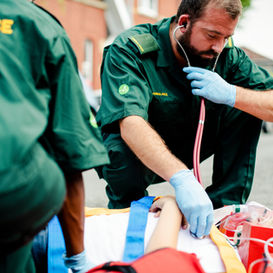

Emergency Medical Training
Course Outline
-
Engineering Controls
-
Personal Protective Equipment
-
Hepatitis B Vaccination
-
Signs / Labels
-
Other Provisions
C.P.R / First Aid
(8 hours)
First Responder Medical
48 Hour (Minimum)
8 Hour First Responder Awareness
24 Hour First Responder Operational
This course will teach participants how to react to a life threatening emergency. The first 4 hours of this course will cover CPR, choking, and appropriate medical techniques. Proper procedures for heat and cold emergencies, injuries to muscles, bones and joints, bleeding emergencies, chemical and heat burns, and how to care for sudden illnesses such as poisonings, seizures, and diabetic emergencies will be covered in the first aid portion of this course. This "hands on" training follows the American Heart Association and the National Safety Council Standards.
Along with the following courses students will address various types of injuries and illnesses, learn to assess and stabilize their patients, and be instructed on how to care for and properly package (prepare) a patient for transport.
This course is designed to provide participants who are first responders with the necessary awareness to have a safe and competent hazardous materials response. Participants learn to recognize what hazardous materials are and the risks and negative outcomes from HAZMAT events. How to use basic clues such as placards, labels, and shipping papers for a safer response will also be covered in this 8 hour course. All students will complete a state certified examination.
This course is designed to provide participants with improved capability to respond to HAZMAT events and identify the need for a mentally safe approach and positive safety attitude. Participants learn to identify a HAZMAT via warning signs, Material Safety Data Sheets, and placards. Other subjects covered include:
-
Protective equipment commonly used
-
Basic implementation of the Incident Command System (ICS)
-
Decontamination techniques
-
Containment methods
-
Documentation and disposal
Bloodborne Pathogens
Bloodborne pathogens are bacteria and viruses present in human blood and body fluids that can cause disease in humans. Employees are at risk when they are exposed on the job to bodily fluids or blood and materials that may cause infections (such as hepatitis B [HBV], human immunodeficiency virus (HIV) which causes acquired immune deficiency syndrome [AIDS]). OSHA requires that employers provide annual training. Our course covers all guidelines established by OSHA, such as engineering controls, personal protective equipment, hepatitis B vaccination, signs/labels, and other provisions.




